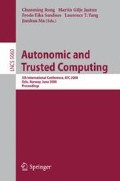Abstract
In recent years, Autonomic and Organic Computing have become areas of active research in the computer science community. Both initiatives aim at handling the growing complexity in technical systems by creating systems with adaptation and self-optimisation capabilities. One application scenario for such “life-like” systems is the control of road traffic signals in urban areas. This paper presents an organic approach to traffic light control and analyses its performance by an experimental validation of the proposed architecture which demonstrates its benefits compared to classical traffic control.
Access this chapter
Tax calculation will be finalised at checkout
Purchases are for personal use only
Preview
Unable to display preview. Download preview PDF.
References
Kephart, J.O., Chess, D.M.: The vision of Autonomic Computing. IEEE Computer 36(1), 41–50 (2003)
Schmeck, H.: Organic Computing – A new vision for distributed embedded systems. In: Proceedings of the 8th IEEE International Symposium on Object-Oriented Real-Time Distributed Computing (ISORC 2005), pp. 201–203 (2005)
Branke, J., Mnif, M., Müller-Schloer, C., Prothmann, H., Richter, U., Rochner, F., Schmeck, H.: Organic Computing – Addressing complexity by controlled self-organization. In: Margaria, T., Philippou, A., Steffen, B. (eds.) Proceedings of the 2nd International Symposium on Leveraging Applications of Formal Methods, Verification and Validation (ISoLA 2006), pp. 200–206 (2006)
Transportation Research Board Washington, D.C.: Highway Capacity Manual (2000)
Robertson, D.I., Bretherton, R.D.: Optimizing networks of traffic signals in real time – the SCOOT method. IEEE Transactions on Vehicular Technology 40(1), 11–15 (1991)
Bretherton, R.D., Rai, G.I.: The use of SCOOT in low flow conditions. Traffic Engineering & Control 23(12), 574–576 (1982)
Sims, A.G., Dobinson, K.W.: The Sydney Coordinated Adaptive Traffic (SCAT) System – Philosophy and Benefits. Proceedings of the International Symposium on Traffic Control Systems 29(2), 19–41 (1980)
Friedrich, B.: Ein verkehrsadaptives Verfahren zur Steuerung von Lichtsignalanlagen. Veröffentlichung des Fachgebiets Verkehrstechnik und Verkehrsplanung. Technische Universität München (1999)
Wilson, S.W.: ZCS: A zeroth level classifier system. Evolutionary Computation 2(1), 1–18 (1994)
Wilson, S.W.: Classifier fitness based on accuracy. Evolutionary Computation 3(2), 149–175 (1995)
Wilson, S.W.: Get real! XCS with continuous-valued inputs. In: Lanzi, P.L., Stolzmann, W., Wilson, S.W. (eds.) IWLCS 1999. LNCS (LNAI), vol. 1813, pp. 209–219. Springer, Heidelberg (2000)
Dam, H.H., Abbass, H.A., Lokan, C.: Be real! XCS with continuous-valued inputs. In: Rothlauf, F., et al. (eds.) Proceedings of the 2005 Workshops on Genetic and Evolutionary Computation (GECCO 2005), pp. 85–87 (2005)
Stone, C., Bull, L.: For real! XCS with continuous-valued inputs. Evolutionary Computation 11(3), 299–336 (2003)
Foy, M.D., Benekohal, R.F., Goldberg, D.E.: Signal timing determination using genetic algorithms. In: Transportation Research Record No. 1365, Transportation Research Board, pp. 108–115 (1992)
Stevanovic, A., Martin, P.T., Stevanovic, J.: VISGAOST: VISSIM-based genetic algorithm optimization of signal timings. In: Proceedings of the 86th Transportation Research Board Meeting (2007)
Sun, D., Benekohal, R.F., Waller, S.T.: Multi-objective traffic signal timing optimization using non-dominated sorting genetic algorithm. In: Proceedings of the IEE Intelligent Vehicles Symposium, pp. 198–203 (2003)
Branke, J., Goldate, P., Prothmann, H.: Actuated traffic signal optimization using evolutionary algorithms. In: Proceedings of the 6th European Congress and Exhibition on Intelligent Transport Systems and Services (ITS 2007) (2007)
Cao, Y.J., Ireson, N., Bull, L., Miles, R.: Distributed learning control of traffic signals. In: Oates, M.J., Lanzi, P.L., Li, Y., Cagnoni, S., Corne, D.W., Fogarty, T.C., Poli, R., Smith, G.D. (eds.) EvoIASP 2000, EvoWorkshops 2000, EvoFlight 2000, EvoSCONDI 2000, EvoSTIM 2000, EvoTEL 2000, and EvoROB/EvoRobot 2000. LNCS, vol. 1803, pp. 117–126. Springer, Heidelberg (2000)
Bull, L., Sha’Aban, J., Tomlinson, A., Addison, J.D., Heydecker, B.: Towards distributed adaptive control for road traffic junction signals using learning classifier systems. In: Bull, L. (ed.) Applications of Learning Classifier Systems, pp. 276–299. Springer, Heidelberg (2004)
Swiss Verkehrs-Systeme AG: VS-Plus webpage, http://www.vs-plus.de
National Electrical Manufacturers Association: NEMA Standards Publication TS 2-2003 v02.06 – Traffic Controller Assemblies with NTCIP Requirements (2003)
Rochner, F., Prothmann, H., Branke, J., Müller-Schloer, C., Schmeck, H.: An organic architecture for traffic light controllers. In: Hochberger, C., Liskowsky, R. (eds.) Informatik 2006 – Informatik für Menschen. LNI, vol. P-93, pp. 120–127. Köllen Verlag (2006)
TSS Transport Simulation Systems: Aimsun webpage, http://www.aimsun.com
Author information
Authors and Affiliations
Editor information
Rights and permissions
Copyright information
© 2008 Springer-Verlag Berlin Heidelberg
About this paper
Cite this paper
Prothmann, H., Rochner, F., Tomforde, S., Branke, J., Müller-Schloer, C., Schmeck, H. (2008). Organic Control of Traffic Lights. In: Rong, C., Jaatun, M.G., Sandnes, F.E., Yang, L.T., Ma, J. (eds) Autonomic and Trusted Computing. ATC 2008. Lecture Notes in Computer Science, vol 5060. Springer, Berlin, Heidelberg. https://doi.org/10.1007/978-3-540-69295-9_19
Download citation
DOI: https://doi.org/10.1007/978-3-540-69295-9_19
Publisher Name: Springer, Berlin, Heidelberg
Print ISBN: 978-3-540-69294-2
Online ISBN: 978-3-540-69295-9
eBook Packages: Computer ScienceComputer Science (R0)

